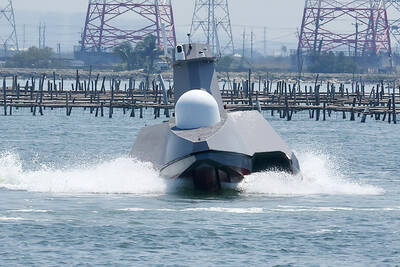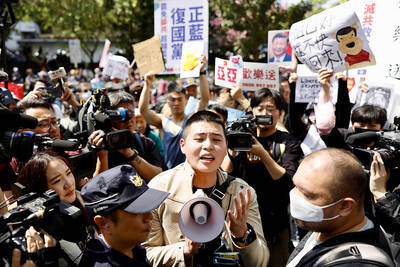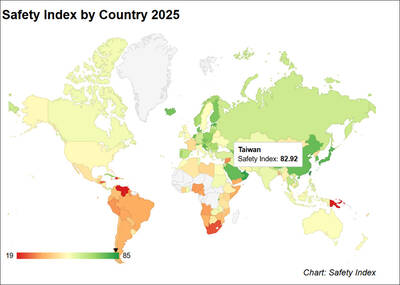While the US has been tied up fighting the war in Iraq, China has made huge gains toward modernizing its military and improving its equipment, and its air defenses are now nearly impenetrable to all but the newest of US fighters, the senior US military official in Japan said.
Lieutenant General Bruce Wright, commander of the roughly 50,000 US forces in Japan, Washington's biggest ally in Asia, said in an interview this week the Iraq War is reducing the availability of US troops and equipment to meet other contingencies and eating up funds that might be used to replace or upgrade planes that are being pushed to their operational limits.
China, meanwhile, is filling the skies with newer, Russian-made Sukhoi Su-27 "Flankers" and Su-30s, along with the domestically built J-10, a state-of-the-art fighter that Beijing just rolled out in January.
China has also improved its ballistic missile defenses and its ability to take the fight into space -- as it proved by shooting down an old weather satellite at an orbital height similar to that used by the US military.
Wright stressed he is "positive" about the current efforts to increase diplomatic and political engagement with Beijing. But he said the Chinese military buildup is disconcerting.
"Are we in trouble? It depends on the scenario," Wright said in the interview on Thursday. "But you have to be concerned about the small number of our forces and the age of our forces."
Wright said the US Air Force's fleet is older than ever.
The average age of the F-15 fighters, for example, is about 24 years, while that of the KC-135 Stratotanker, a mid-air refueling plane that is a key element in the Air Force's ability to conduct long-range missions, is 46 years.
Wright, who was at this air base on Japan's southern island of Okinawa to meet with local commanding officers, said the improvement in Chinese air defenses had made China's airspace "difficult if not impossible" to penetrate with the kind of US fighters -- F-15s and F-16s -- now deployed in Japan.
Doing so would require the F-22 or the Joint Strike Fighter, which both have stealth capabilities. The Air Force sent a dozen F-22s to Japan earlier this year, but only for a temporary deployment. It has no plans to send more there permanently.
The Joint Strike Fighter, or F-35, is not yet combat-ready.
"Our planes are much older than the planes they would be matched against," Wright said. "For the first time in history, we are seeing another nation, in this case China, with newer fighters than we have. We know that they continue to invest at a level that is unprecedented. We need to be watchful of Chinese military capabilities."
He said the demands of supporting ground troops in Iraq has pushed the Air Force to draw on its fighters from virtually anywhere they can be found. Two US F-16 fighter squadrons from the base in Misawa, Japan, are rotating in and out of Iraq.
"The question is how much more are they going to need," he said. "They are already pulling them out of Misawa, so where else are they going to come from?"
Wright said Beijing is also at an advantage because it is not at war.
Also see story:
Taiwan developing long-range missiles: analysts

ENDEAVOR MANTA: The ship is programmed to automatically return to its designated home port and would self-destruct if seized by another party The Endeavor Manta, Taiwan’s first military-specification uncrewed surface vehicle (USV) tailor-made to operate in the Taiwan Strait in a bid to bolster the nation’s asymmetric combat capabilities made its first appearance at Kaohsiung’s Singda Harbor yesterday. Taking inspiration from Ukraine’s navy, which is using USVs to force Russia’s Black Sea fleet to take shelter within its own ports, CSBC Taiwan (台灣國際造船) established a research and development unit on USVs last year, CSBC chairman Huang Cheng-hung (黃正弘) said. With the exception of the satellite guidance system and the outboard motors — which were purchased from foreign companies that were not affiliated with Chinese-funded

PERMIT REVOKED: The influencer at a news conference said the National Immigration Agency was infringing on human rights and persecuting Chinese spouses Chinese influencer “Yaya in Taiwan” (亞亞在台灣) yesterday evening voluntarily left Taiwan, despite saying yesterday morning that she had “no intention” of leaving after her residence permit was revoked over her comments on Taiwan being “unified” with China by military force. The Ministry of the Interior yesterday had said that it could forcibly deport the influencer at midnight, but was considering taking a more flexible approach and beginning procedures this morning. The influencer, whose given name is Liu Zhenya (劉振亞), departed on a 8:45pm flight from Taipei International Airport (Songshan airport) to Fuzhou, China. Liu held a news conference at the airport at 7pm,

Taiwan was ranked the fourth-safest country in the world with a score of 82.9, trailing only Andorra, the United Arab Emirates and Qatar in Numbeo’s Safety Index by Country report. Taiwan’s score improved by 0.1 points compared with last year’s mid-year report, which had Taiwan fourth with a score of 82.8. However, both scores were lower than in last year’s first review, when Taiwan scored 83.3, and are a long way from when Taiwan was named the second-safest country in the world in 2021, scoring 84.8. Taiwan ranked higher than Singapore in ninth with a score of 77.4 and Japan in 10th with

GRIDLOCK: The National Fire Agency’s Special Search and Rescue team is on standby to travel to the countries to help out with the rescue effort A powerful earthquake rocked Myanmar and neighboring Thailand yesterday, killing at least three people in Bangkok and burying dozens when a high-rise building under construction collapsed. Footage shared on social media from Myanmar’s second-largest city showed widespread destruction, raising fears that many were trapped under the rubble or killed. The magnitude 7.7 earthquake, with an epicenter near Mandalay in Myanmar, struck at midday and was followed by a strong magnitude 6.4 aftershock. The extent of death, injury and destruction — especially in Myanmar, which is embroiled in a civil war and where information is tightly controlled at the best of times —